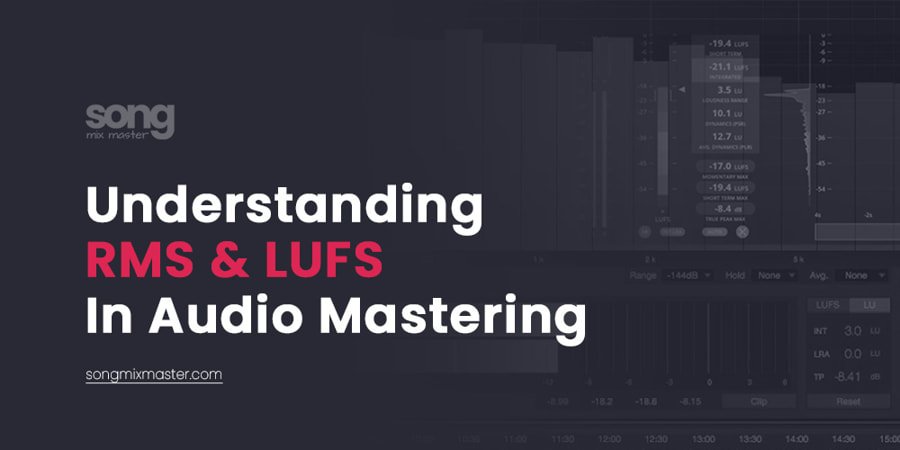Mastering
Understanding RMS and LUFS in Audio Mastering
Understanding the differences and applications of RMS and LUFS can significantly impact the quality of your final product. Calling music a “product” might sound too commercial, but Music is sold and purchased in various formats such as digital downloads, CDs, vinyl records, and streaming subscriptions.
The logistics of distributing music align closely with how products are distributed in other industries, so makes music a commercial product…
These two primary metrics used in the industry are RMS (Root Mean Square) and LUFS (Loudness Units relative to Full Scale), which serve a distinct purpose and provide unique insights into the audio signal’s characteristics.
Let’s explore these concepts, how they differ, and why mastering engineers often prefer one over the other.
RMS: A Traditional Measure of Loudness
RMS (Root Mean Square) is a statistical measure of the magnitude of a varying quantity. In audio, it reflects the average power of the signal, giving us an indication of how “loud” a sound is perceived over time.
The RMS level is crucial because it informs us about the average energy in the audio signal.
Historically, different eras of music have demonstrated varying RMS levels. For instance, music from the ’70s, ’80s, and ’90s generally exhibits lower RMS levels compared to modern tracks. This is primarily due to the less aggressive use of compression in older recordings, resulting in greater dynamic range.
In practical terms, RMS levels for most contemporary mixes are recommended to fall between -12dB RMS and -6dB RMS. However, this is a guideline rather than a rule.
Different genres necessitate different RMS levels:
- Hip-hop/Electronic Music: Often around -3dB RMS due to their aggressive and upfront nature.
- Classical/Jazz: Typically around -14dB RMS, preserving more of the dynamic range inherent to these genres.
When preparing a mix for mastering, balancing the various elements without introducing peaks and distortion is vital. Mastering engineers often employ compression and limiting to adjust RMS levels, effectively raising the perceived loudness by controlling the peaks.
Also read: What is RMS in Music Mastering
LUFS: A Modern Approach to Loudness
LUFS (Loudness Units relative to Full Scale) has become the standard for loudness measurement, especially in the broadcasting and streaming sectors.
Unlike RMS, LUFS considers the human ear’s sensitivity to different frequencies, providing a more accurate representation of perceived loudness.
The Integrated LUFS value offers a comprehensive view of the entire track’s loudness, while Short-term and Momentary LUFS values help in assessing loudness over shorter periods.
This granularity makes LUFS particularly useful in environments where consistent loudness across various media is essential.
Also see: Best Plugins for Measuring LUFS
RMS vs. LUFS: Which is Best for Mastering?
While RMS has been a long-standing metric in audio production, LUFS is often considered superior for several reasons:
- Human Perception: LUFS aligns more closely with how we perceive loudness, taking into account frequency sensitivity and temporal effects.
- Dynamic Range: LUFS offers better insights into the dynamic range, helping to maintain the musicality and emotional impact of the audio.
- Consistency: LUFS provides consistent loudness measurements, which is crucial for platforms with loudness normalization policies, such as streaming services (Spotify, Tidal, YouTube, Apple Music, etc).
Also read: Mastering at the Right Loudness for Streaming Platforms
For these reasons, LUFS is generally preferred for metering loudness in modern audio mastering. However, understanding both RMS and LUFS is essential for a comprehensive approach to mastering, ensuring the final product is both technically sound and musically satisfying.
Also read: Mixing Vs. Mastering – The Main Differences
Practical Application in Mastering
When mastering, a professional audio engineer will typically start by analyzing the mix using both RMS and LUFS meters. This dual approach ensures a balanced and well-rounded perspective on the audio signal.
- Compression and Limiting: These tools are used to control dynamic range and adjust the RMS level. A balanced approach prevents excessive loudness while preserving the track’s integrity.
- Loudness Normalization: Employing LUFS measurements helps achieve consistent loudness levels across different platforms, adhering to industry standards such as -14 LUFS for streaming services.
Also read: Mastering Your Tracks at -14 LUFS: Good or Bad?
In conclusion, while RMS remains a useful tool for understanding the average power of an audio signal, LUFS offers a more nuanced and perceptually accurate measurement of loudness.
By integrating both metrics, mastering engineers can ensure their tracks meet contemporary loudness standards while retaining the desired artistic dynamics.
Consulting with a professional mastering engineer is always advisable to achieve the best possible outcome for your audio projects. Check out our audio services.


Disclaimer: Any references to any brands on this website/webpage, including reference to products, trademarks, brands and companies, are provided for description purposes only. We don't have any association with or endorsement by these brands or companies. Some of the links on our blog may be affiliate links. This means if you click on these links and make a purchase, we may earn a commission at no extra cost to you.
Need Professional Mixing & Mastering?
You may also like to read...
How To Improve The Sound Acoustic in a Home Studio
Audio Compression And “The Anticipation Method”
Soundproofing and Acoustic Treatment – Myths and Realities
The Warm, Expansive Sound of Analog Summing Mixing
How to Use Mid/Side EQ with FL Studio’s Stock Plugins
Top 5 Mistakes When Using Reverb in Audio Mixing